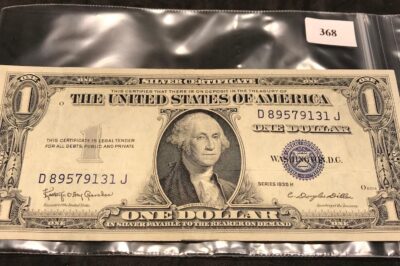
In the vast tapestry of American currency, certain notes stand out not only for their monetary value but also for their historical significance and unique designs. Among these is the $1 Silver Certificate issued in 1935, a piece of currency that holds both monetary and historical importance. Let’s delve into the intriguing story behind this iconic banknote.
A Brief History
In the early 20th century, the United States operated on a bimetallic standard, where both gold and silver served as backing for the nation’s currency. However, the scarcity of silver led to the gradual abandonment of the silver standard, with gold becoming the primary metal backing the U.S. dollar.
Despite this shift, silver certificates continued to circulate alongside Federal Reserve Notes. These certificates were essentially promissory notes issued by the U.S. Treasury, redeemable for a specific quantity of silver. The $1 Silver Certificate of 1935 was part of this series, representing a dollar’s worth of silver.
Design and Features
One of the most striking aspects of the 1935 $1 Silver Certificate is its design. On the obverse side, it features the portrait of George Washington, the first President of the United States, in the center. Surrounding his portrait are intricate patterns and designs, including the Great Seal of the United States and the series date.
The reverse side of the note showcases the familiar image of the Great Seal of the United States, flanked by decorative elements and the denomination “ONE DOLLAR.” The design is notable for its simplicity yet elegance, characteristic of the currency of that era.
Collectibility and Value
Today, the 1935 $1 Silver Certificate holds significant collectible value among numismatists and currency enthusiasts. While many of these notes were in circulation for decades, pristine specimens or those with unique features can fetch considerable sums at auctions or through private sales.
Factors such as the condition of the note, rarity, and any printing errors or unique serial numbers can influence its value. Collectors often seek out well-preserved examples with minimal signs of wear and tear, as these command the highest prices in the market.
Legacy and Cultural Impact
Beyond its monetary value, the $1 Silver Certificate from 1935 carries a cultural and historical legacy. It serves as a tangible reminder of a bygone era when silver played a more prominent role in the nation’s currency system. Additionally, the iconic imagery of George Washington and the Great Seal symbolizes the ideals and values of the United States.
For many collectors, owning a piece of history in the form of a 1935 $1 Silver Certificate is a way to connect with the past and appreciate the artistry and craftsmanship of American currency. Each note tells a story, reflecting the economic, political, and cultural landscape of its time.
Conclusion
In the realm of numismatics, few pieces of currency evoke as much fascination and nostalgia as the $1 Silver Certificate from 1935. Beyond its face value, this banknote represents a tangible link to America’s past, showcasing the artistry, history, and cultural significance of its era. Whether as a collectible item or a historical artifact, the 1935 $1 Silver Certificate continues to captivate enthusiasts and collectors alike, reminding us of the enduring legacy of American currency.









